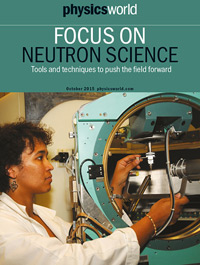Tag archives: neutrons
A temporary lack of neutrons
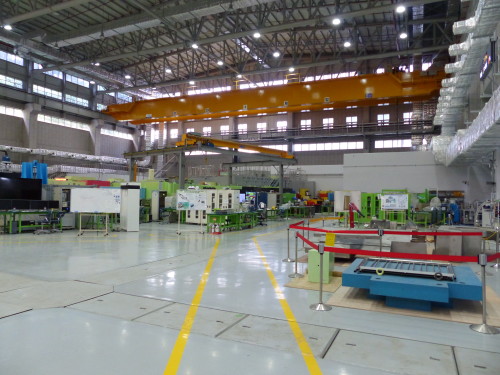
The guide hall at the HANARO research reactor in Daejeon, Republic of Korea.
By Margaret Harris in Daejeon, Republic of Korea
For almost three years, the HANARO research reactor has been idle. Built in 1995 as a hub for neutron-scattering experiments, radioisotope production and other scientific work, HANARO (High Flux Advanced Neutron Application Reactor) is the only facility of its kind in the Republic of Korea, and it underwent a major upgrade in 2009. Then, in 2014, the facility became a delayed casualty of the meltdown at Japan’s Fukushima Dai-Ichi nuclear power station, as enhanced regulatory scrutiny led to the discovery that the reactor hall’s outer wall was not up to the latest standards. An enforced shutdown followed while the wall was reinforced, and although the works were supposed to take just 18 months, opposition from local citizens’ groups has led to further delays.
View all posts by this author | View this author's profile
The 2016 Physics World Focus on Neutron Science is out now
By Michael Banks
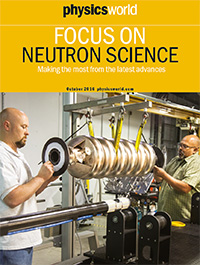 Neutron scientists in Europe are facing a number of headwinds in the coming decade. One is the uncertainty caused by the recent UK vote to leave the European Union. Another is the impending closure of ageing reactors across the continent such as the Orphée reactor in Paris and the BER II reactor in Berlin, which could both shut down by 2020.
Neutron scientists in Europe are facing a number of headwinds in the coming decade. One is the uncertainty caused by the recent UK vote to leave the European Union. Another is the impending closure of ageing reactors across the continent such as the Orphée reactor in Paris and the BER II reactor in Berlin, which could both shut down by 2020.
A recent report by an expert group of researchers – the Neutron Landscape Group – paints a worrying challenge for neutron scientists. It forecasts that the continent’s supply of neutrons could drop by as much as a half over the next decade – a shortfall in capacity that is unlikely to be met by the upcoming European Spallation Source in Lund, Sweden.
That said, there are plans to help overcome the impending neutron gap, including proposals to plug it by building compact, specialist sources. Improvements to accelerator technology and instruments could also help by boosting the number of usable neutrons. Scientists at the US Spallation Neutron Source, for example, are pioneering a method to improve its proton beam energy using plasma processing, while the National Institute of Standards and Technology’s world-leading neutron microscope will soon open up to users.
View all posts by this author | View this author's profile
Putting China at the forefront of neutron science
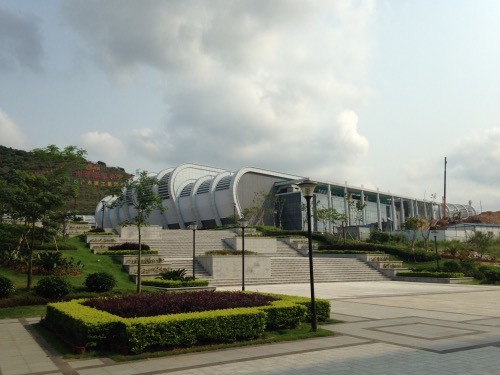
The target station for the China Spallation Neutron Source in Dongguan, China.
By Michael Banks in Dongguan, Guangdong province, China
Today I took the 60 km trip north from Shenzhen to Dongguan – home of the China Spallation Neutron Source (CSNS).
China has two nuclear reactors that generate neutrons for research via nuclear fission, but the CSNS is the country’s first spallation source. This type of facility accelerates protons before smashing them into a target to produce copious amounts of neutrons. They are then sent to numerous instruments that are used by researchers to study materials.
View all posts by this author | View this author's profile
Physics World 2015 Focus on Neutron Science is out now
By Michael Banks
For physicists who love scattering neutrons off materials, the recent ground-breaking ceremony at the European Spallation Source (ESS) in Lund, Sweden, will have been a long time coming. First proposed more than two decades ago, the ESS will – when it finally opens in 2020 – generate the world’s most intense beams of neutrons and help satisfy demand for these most useful of particles.
Neutron scattering has emerged as a mainstream scientific endeavour over the last 20–30 years, which is one reason why this month sees the first-ever Physics World focus issue on neutron science. We take a look at how researchers at the ESS are designing the facility’s tungsten target, as well as a new neutron source being built in China and how the ISIS Neutron and Muon Source in the UK is looking to bring in more users from industry.
View all posts by this author | View this author's profile
Quantum Cheshire cat spotted in Grenoble

A most curious thing is the quantum Cheshire cat. (Courtesy: iStockphoto/koffeezilla)
By Hamish Johnston
Three months ago we ran a news article about a “quantum Cheshire cat” experiment that was proposed by Yakir Aharonov of Tel Aviv University and colleagues. Now, an international team of physicists has created a quantum Cheshire cat using polarized neutrons at the Institut Laue-Langevin (ILL) in Grenoble, France.
The work was done by Yuji Hasegawa and colleagues at the Vienna University of Technology, ILL, the University of Cergy-Pontoise and Chapman University.
View all posts by this author | View this author's profile
Institut Laue-Langevin secures funding until 2023
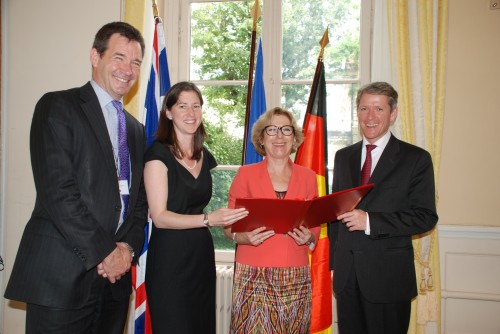
Smiles all around in Paris. From left to right are ILL director-general Andrew Harrison, Hermione Gough of the British Embassy, the French minister for higher education Geneviève Fioraso and Peter Reuss of the German Embassy. (Courtesy: ILL)
By Hamish Johnston
Despite the tough economic conditions in much of Europe, scientists who use one of the continent’s leading scientific facilities have something to smile about. The UK, France and Germany have agreed to continue funding the Institut Laue-Langevin (ILL) neutron facility for at least another decade.
View all posts by this author | View this author's profile
View from the beamlines
By James Dacey
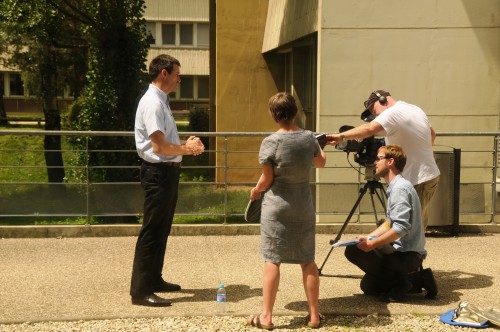
This photo looks a little bit like we were filming the moment that I got down on my knee and popped the big question to Andrew Harrison, the Director General of the Institut Laue-Langevin (ILL). While that would certainly make for an intriguing story worthy of a blog entry, the truth is that earlier this week we were interviewing Harrison for a short film about his international research facility. In case you are still wondering, the reason I am kneeling is so that we could frame our shot to include the dome that houses the ILL’s nuclear reactor, where neutrons are generated.
View all posts by this author | View this author's profile
